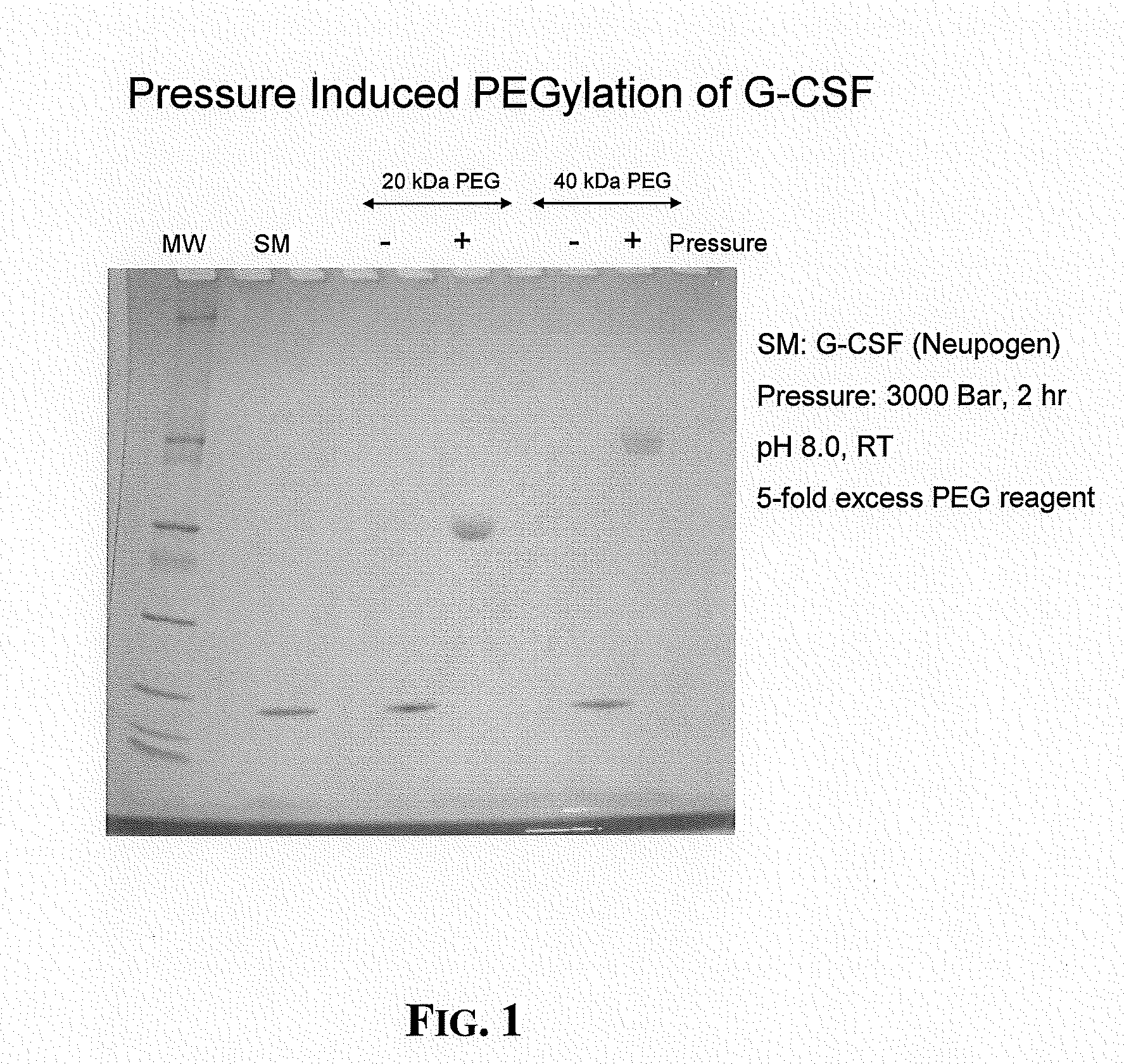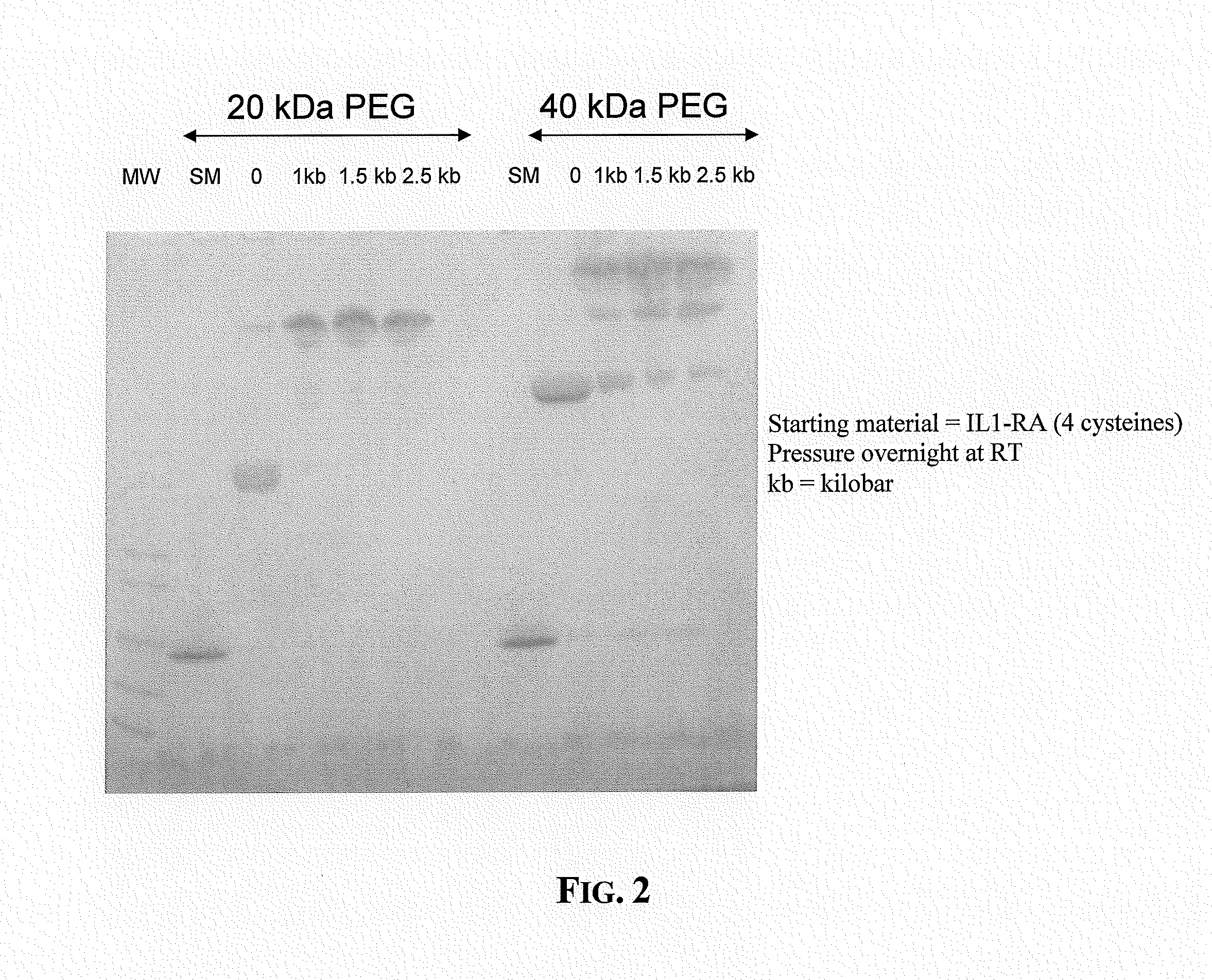Method for Derivatization of Proteins Using Hydrostatic Pressure
a technology of hydrostatic pressure and derivatization method, which is applied in the field of protein biochemistry, can solve the problems of protein and a higher risk of toxicity, protein typically contains several lysine residues, and recombinant proteins are often used, and achieve the effect of increasing the reactivity of a functional group
- Summary
- Abstract
- Description
- Claims
- Application Information
AI Technical Summary
Benefits of technology
Problems solved by technology
Method used
Image
Examples
example 1
[0058]This example illustrates production of pegylated G-CSF molecules prepared in accordance with the present invention. G-CSF (NEUPOGEN®, Amgen Inc., Thousand Oaks, Calif.) was diluted with 100 mM Tris pH 8 to a final concentration of 100 μg / ml. A 5× fold excess of 20 kDa or branched 40 kDa maleimide (Nippon Oil and Fats Co., Ltd., Tokyo, Japan) was added to two ml aliquots of the diluted protein. One ml of each pegylation reaction mixture was loaded into a caisson and subjected to high hydrostatic pressure (3 kilobars) for 2 hours at room temperature. Pressure was generated using high-pressure nitrogen (400 bar) connected to a 10-fold hydraulic intensifier equipment (High Pressure Equipment Company, Erie, Pa.). The remainder of the pegylation reaction mixture was allowed to sit at atmospheric pressure. After depressurizaton, the protein samples were analyzed by non-reducing SDS-PAGE analysis (10-20% polyacrylamide gels, NOVEX®, San Diego, Calif.) using a coomassie stain for detec...
example 2
[0059]This example illustrates production of pegylated Il-1RA molecules prepared in accordance with the present invention. Il-1RA (KINERET® , Amgen, Inc, Thousand Oaks, Calif.) was diluted to a final concentration of 1 mg / ml with 100 mM Tris, pH 8. A 5× fold excess of 20 kDa or branched 40 kDa Maleimide PEG (NOF) was added to 2 ml aliquots. One ml of each pegylation reaction mixture was loaded into individual caissons and subjected to hydrostatic pressures ranging from 1 kilobar to 2.5 kilobars for 16 hour at room temperature. The remaining 1 ml of the pegylation reaction mixture was allowed to sit at room temperature for the same amount of time. After depressurizaton, the protein samples were analyzed by reducing SDS-PAGE analysis (10-20% polyacrylamide gels, NOVEX®, San Diego, Calif.) using a coomassie stain for detection. The results are shown in FIG. 2. At atmospheric pressure, only one cysteine reacted with the PEG reagent. At pressures ranging from 1 kilobar to 2.5 kilobars, a...
PUM
| Property | Measurement | Unit |
|---|---|---|
| molar ratio | aaaaa | aaaaa |
| molecular weights | aaaaa | aaaaa |
| concentration | aaaaa | aaaaa |
Abstract
Description
Claims
Application Information
 Login to View More
Login to View More - R&D
- Intellectual Property
- Life Sciences
- Materials
- Tech Scout
- Unparalleled Data Quality
- Higher Quality Content
- 60% Fewer Hallucinations
Browse by: Latest US Patents, China's latest patents, Technical Efficacy Thesaurus, Application Domain, Technology Topic, Popular Technical Reports.
© 2025 PatSnap. All rights reserved.Legal|Privacy policy|Modern Slavery Act Transparency Statement|Sitemap|About US| Contact US: help@patsnap.com


